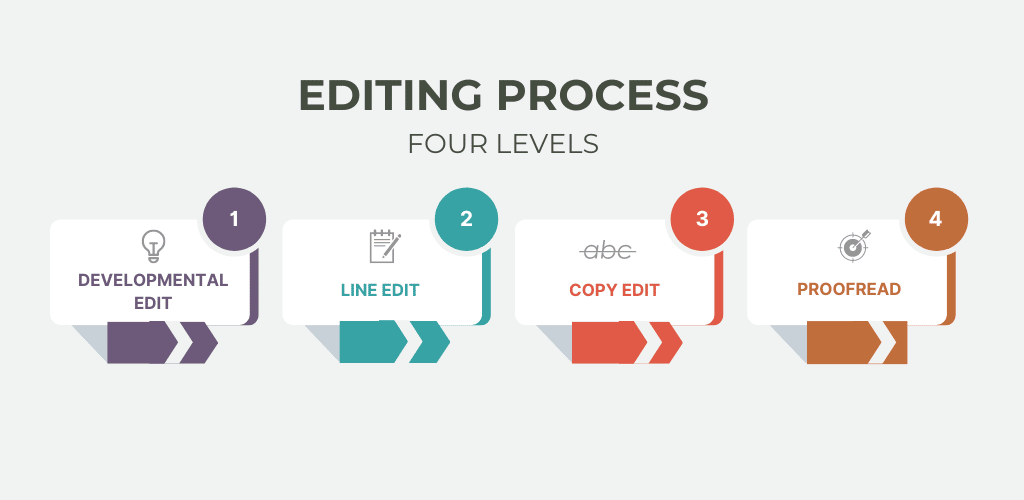Types of Editing
Four Levels of editing

You’ve written your book and completed a couple rounds of self-editing. Now you need an editor, but you quickly realize after researching the different types of editing that there is no one-size-fits-all service. So how do you know which service you need?

Looks for issues that affect the whole book, like weaknesses in plot, pacing, character arcs, POV, and overall story. A developmental editor may suggest rearranging, rewriting, or removing scenes.

Focuses on style and consistency. A line edit doesn’t just fix grammar problems but also improves the story’s readability. It points out word repetitions, character inconsistencies, word usage issues, clichés, spelling errors, and grammar missteps.

Corrects and maintains consistency in grammar, punctuation, and spelling. It includes basic fact-checking and checks for usage and style based on a guide such as The Chicago Manual of Style.

Once your book has been formatted, a proofreader double-checks for grammar and spelling issues and looks for any formatting problems so that your book will look correct in its published form.
WHERE SHOULD YOU START?
Editing is a bit like constructing a home. There are different stages to building a house, just like there are different stages to editing.
- The first construction stage is like the bones of the house—foundation, framing, plumbing, etc. This first stage is equivalent to a developmental edit.
- The second stage is decorative—drywall, cabinets, flooring, paint, etc. These are like line editing and copy editing.
- The third stage is the final inspection which is like proofreading.
When building a house, some stages are only possible after others are completed, and some would cause problems if done out of order.

For instance, you can’t attach drywall to a house without framing, and the building can’t pass the final inspection if the toilets aren’t installed.
It’s the same with editing, which begins with a developmental edit, then a line edit, then a copy edit, and finally a proofread.
Let’s say a writer hired a proofreader and then realized they needed a developmental edit. The developmental editor might suggest that certain scenes be removed or rewritten. Now the work done in that initial proofread will be deleted, and the new scenes will need to be proofread again.
So, to avoid wasting time and money, it’s best to figure out the highest editing level you need and start there.
STILL UNSURE WHAT TYPE OF EDIT YOU NEED?
Now you know the different types of editing levels and the order in which they should be done.
- Developmental Edit
- Line Edit
- Copy Edit
- Proofread
The key point is to figure out the type of editing services your book needs and have them completed in the order listed above.
If you want a developmental edit and a copy edit, then start at the top with a developmental edit and then proceed to the copy edit.
FIGURE OUT THE HIGHEST EDITING LEVEL YOU NEED AND START THERE
Avoid bouncing around or going from the bottom to the top. For instance, with the previous example, you would want to avoid doing the copy edit first and then finishing with the developmental edit.
Figuring out the types of editing your book needs can be overwhelming and confusing, but I’m happy to help writers navigate it. So feel free to contact me and ask any questions you may have. I can’t wait to hear from you.
